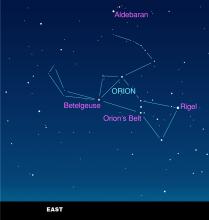Listen to today's episode of StarDate on the web the same day it airs in high-quality streaming audio without any extra ads or announcements. Choose a $8 one-month pass, or listen every day for a year for just $30.
You are here
More ‘O’ Stars
The Orion Nebula is about 1500 light-years away, yet it’s easily visible to the unaided eye. It’s a complex of thousands of newborn stars. But it shines so brightly thanks mainly to just one of those stars. It’s a member of the most impressive class of stars in the galaxy — class “O.”
O stars are the hottest, brightest, and heaviest stars in the galaxy. Their high surface temperatures make them shine blue-white.
An example is the bright star at the heart of the Orion Nebula, known as Theta-1 Orionis C-1. It’s probably more than 30 times the Sun’s mass and 20 times its diameter. Combined with its temperature, that makes it a quarter of a million times brighter than the Sun.
O stars usually are found in stellar nurseries, such as the Orion Nebula. That’s mainly because they live for only a few million years — not enough time to move far from where they were born.
While they’re there, they have a major impact on the surrounding nebula. Their radiation causes the surrounding gas to glow. The radiation also evaporates much of the surrounding gas and dust. That can shut down the process of starbirth around the star. But the star’s radiation and winds can squeeze nearby clumps of gas and dust, causing them to give birth to new stars.
O stars also create many of the chemical elements. At the ends of their lives, the stars explode, scattering the elements into space. That provides the raw materials for new stars, planets — and perhaps life.
Script by Damond Benningfield





